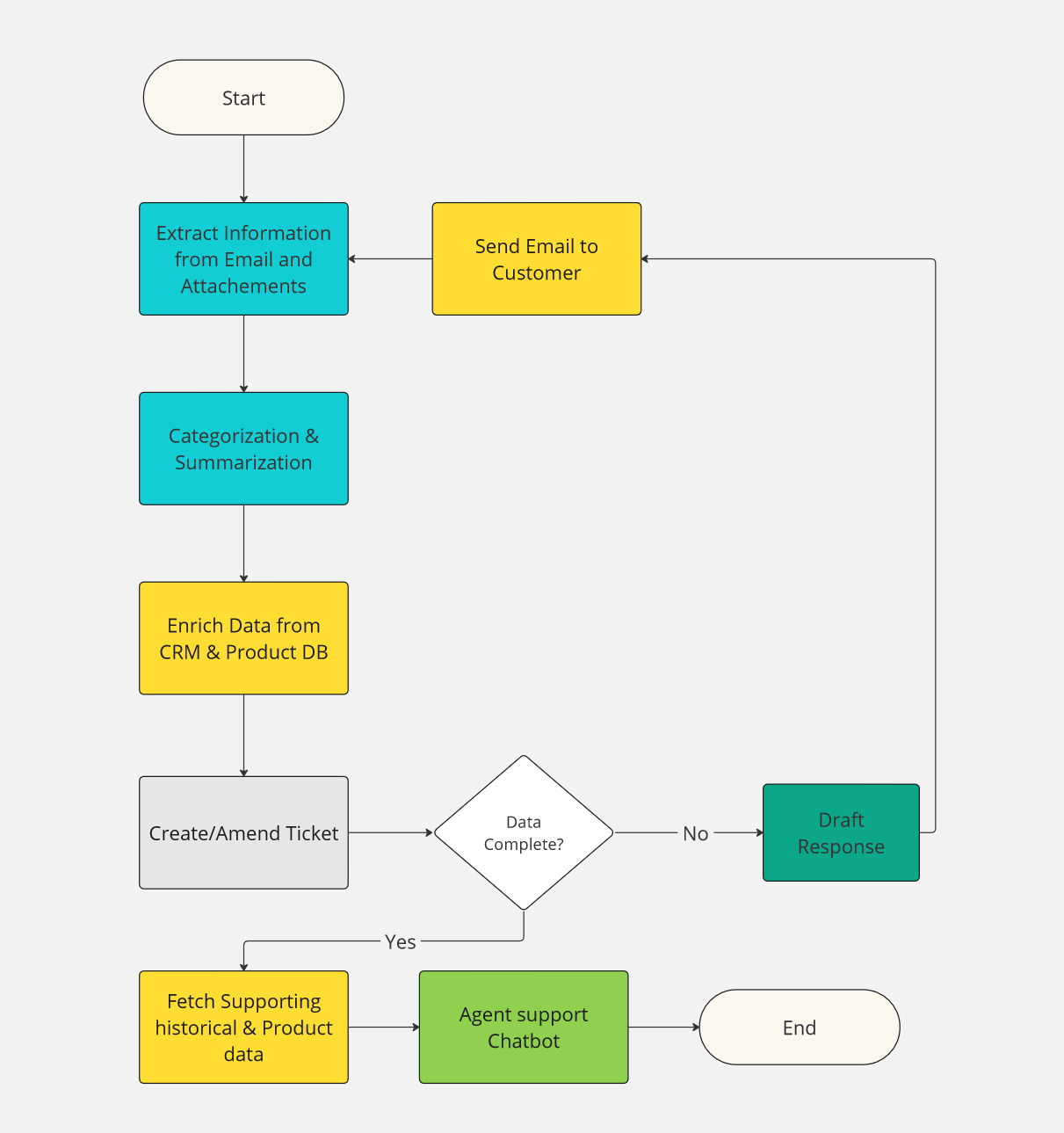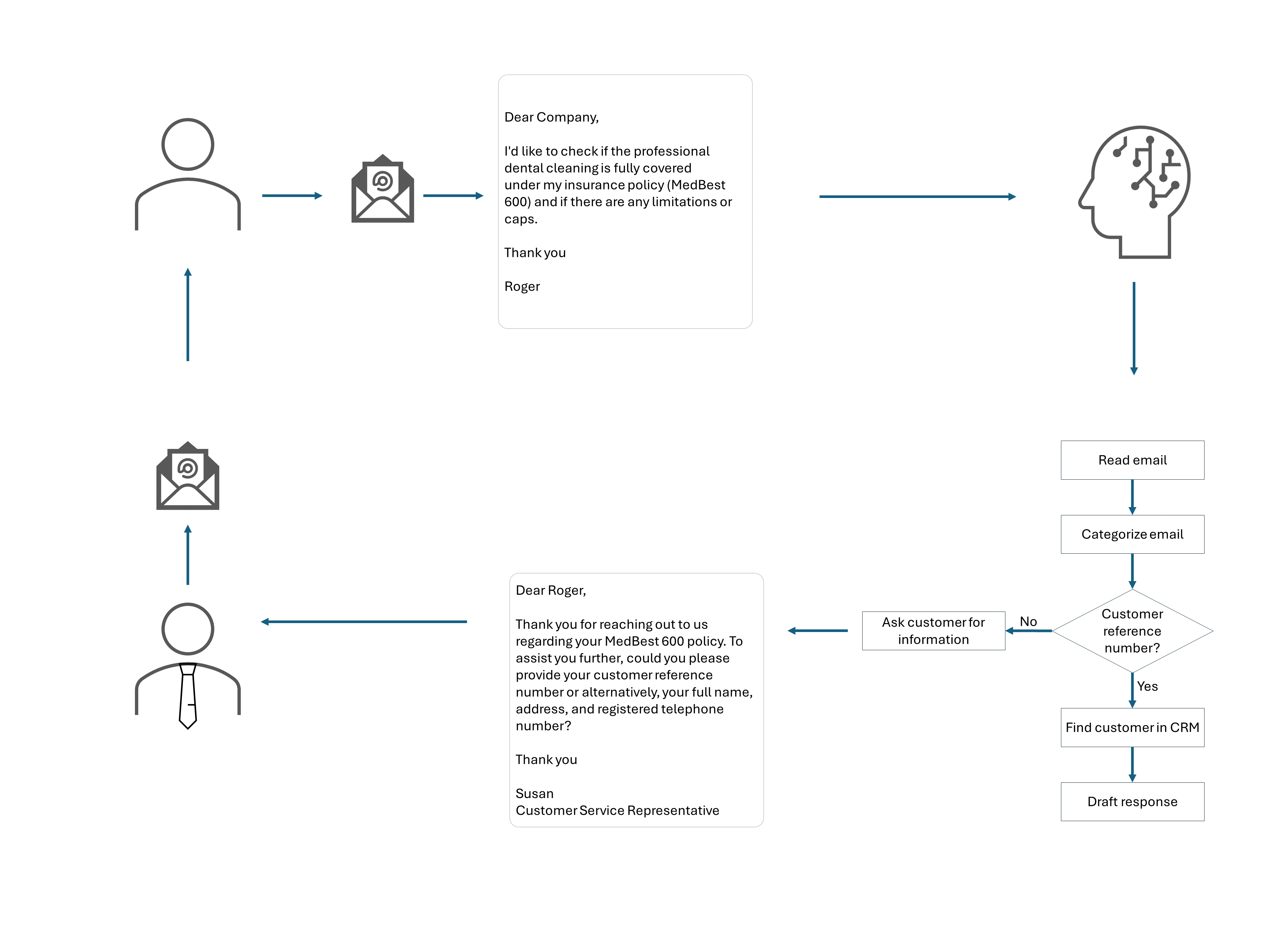In today’s fast-paced business environment, AI-driven customer service is revolutionizing how companies handle customer interactions and streamline their workflows. Building upon concepts discussed in our previous articles, this piece explores a comprehensive customer service automation solution powered by advanced AI technologies. Let’s break down the process step by step.
Email Retrieval
The workflow begins by fetching emails using an email Application Programming Interface (API). The API allows secure access to email accounts programmatically, enabling the system to retrieve new messages as they arrive. It provides various methods to filter and sort emails, ensuring that only relevant messages are processed.
This initial step aligns with the strategies we discussed in our recent post, “AI-Driven Email Automation: Future of Business Efficiency”, where we explored how automating email workflows can drastically enhance operational efficiency.
Email Categorization
Once an email is retrieved, a Large Language Model (LLM) is employed to categorize the message. LLMs are advanced AI models trained on vast amounts of text data, capable of understanding context and nuance in natural language. In the context of AI-driven customer service, the LLM doesn’t just look for keywords but comprehends the overall context, tone, and intent of the message. It can handle various writing styles, colloquialisms, and even misspellings or grammatical errors.
For example, the LLM can categorize an email into one of several categories:
- Insurance Claim: Recognizes language related to accidents, damages, or requests for compensation.
- Request for Information: Identifies inquiries about policies, coverage details, or general questions.
- Charge Dispute: Detects language indicating disagreement with charges, billing issues, or refund requests.
- General Customer Service: Covers a wide range of general inquiries, complaints, or requests for assistance.
This categorization is crucial for determining the appropriate next steps and prioritizing responses, a key feature of effective customer service automation. The use of sophisticated models like LLMs ensures high accuracy and efficiency in handling diverse customer queries.
For a deeper understanding of how different AI models contribute to workflow optimization, refer to our article on “The Power of Mixture of Experts (MoE) in Workflow Automation”, where we delve into advanced AI architectures enhancing automation processes.
Extracting Customer Information
The next step involves using a general-purpose LLM to automatically scan incoming emails for key customer information. Despite not being specially trained for this specific task, the LLM leverages its broad understanding of language to identify and extract essential details such as the customer’s full name, phone number, email address, and policy number. This capability is central to AI-driven customer service, where quick and accurate information extraction is critical to efficient support.
Once this information is identified, it is automatically transferred to the relevant fields in the customer management system, ensuring that each email is correctly linked to the appropriate customer records. This seamless integration enhances response times and reduces the potential for human error, contributing to a more streamlined and effective customer service experience.

Creating Tickets in Customer Relationship Management (CRM) system
With the email categorized and customer information extracted, the system proceeds to create a ticket in the Customer Relationship Management (CRM) system using its API. Platforms like HubSpot offer robust APIs that allow for seamless integration and automation within customer service workflows.
The ticket creation process includes:
- Assigning the Appropriate Category: Ensuring the issue is directed to the right department or team member.
- Attaching Relevant Customer Information: Providing all necessary details for quick and personalized service.
- Setting Priority Levels: Prioritizing tickets based on the urgency and nature of the inquiry.
Additionally, the LLM summarizes the email content and generates a concise subject line for the ticket. This summary provides a quick overview of the customer’s issue, giving representatives an immediate understanding without reading the entire email. Crafting effective summaries and subject lines exemplifies how customer service automation enhances efficiency and accuracy in handling customer inquiries.
Our AI Automation for Ticketing Systems Solution streamline this process, allowing for seamless customer service automation.
Handling Missing Customer Information
In scenarios where essential customer details are missing from the email, the workflow is equipped to address these gaps efficiently. When the initial scan does not retrieve all necessary information, the system automatically initiates an additional step to obtain the missing data without delaying the resolution process.
The workflow employs another instance of the general-purpose LLM to draft a personalized follow-up email requesting the required information. This LLM utilizes its understanding of the original message’s context and content to compose a contextually appropriate and courteous request. This proactive approach ensures continuity in customer interactions and maintains high standards of service.
This method aligns with the strategies discussed in our blog post, “Enhancing AI Accuracy and Reliability with Corrective RAG”, where we explore techniques to improve AI systems’ performance and reliability through iterative feedback and data correction mechanisms.
Drafting Replies to Customer Emails
When responding to customer emails, especially those requiring detailed and accurate information about company policies, the system leverages an advanced LLM equipped with Retrieval-Augmented Generation (RAG) capabilities. This approach combines the natural language processing power of the LLM with the ability to retrieve relevant information from extensive databases of company policies, guidelines, and other reference materials.
Process Overview:
- Understanding the Query: The LLM analyzes the customer’s email to comprehend the specific information and context required.
- Retrieving Relevant Information: Utilizing RAG, the LLM accesses and extracts pertinent data from internal knowledge bases.
- Generating a Comprehensive Response: The LLM integrates the retrieved information into a well-crafted, contextually appropriate reply that addresses the customer’s needs effectively.
The drafted response is then reviewed by a customer service representative, who can make any necessary adjustments before sending it to the customer. This collaboration between AI and human oversight ensures high-quality, accurate, and personalized customer service interactions.
For more insights into how RAG enhances AI responses’ accuracy and reliability, revisit our detailed exploration in “Enhancing AI Accuracy and Reliability with Corrective RAG”.
Benefits of This AI-Driven Customer Service Workflow Automation
Implementing AI-driven customer service automation offers numerous advantages:
These benefits underscore the transformative impact of integrating advanced AI technologies into customer service operations, as further elaborated in our article on “AI-Driven Email Automation: Future of Business Efficiency”.
Challenges and Considerations
While AI-driven customer service automation brings significant improvements, it’s essential to be mindful of potential challenges:
- Data Privacy: Ensuring compliance with data protection regulations when handling sensitive customer information.
- Accuracy: Regular monitoring and fine-tuning of AI models to maintain and improve performance.
- Handling Complex Queries: Developing systems capable of addressing nuanced or atypical customer issues effectively.
- Human Oversight: Maintaining a balance between automation and human intervention to ensure empathy and understanding in customer interactions.
Addressing these challenges involves continuous evaluation and adaptation of AI systems, incorporating feedback mechanisms as discussed in “The Power of Mixture of Experts (MoE) in Workflow Automation” and “Enhancing AI Accuracy and Reliability with Corrective RAG”.
Conclusion
AI-driven customer service automation represents a significant advancement in delivering efficient, accurate, and personalized customer support. By leveraging technologies like email APIs, Large Language Models, and Retrieval-Augmented Generation, businesses can enhance their responsiveness and customer satisfaction levels dramatically. To see how our products can help your business achieve these benefits, explore our customer service automation use case.
As AI continues to evolve, integrating innovative approaches such as Mixture of Experts and Corrective RAG will further refine and optimize customer service processes. Staying informed and adaptable to these advancements is crucial for businesses aiming to maintain a competitive edge in today’s dynamic market landscape.
For more in-depth discussions on these topics, explore our previous articles:






